Content-Encoding And Accept-Encoding
透過瀏覽器觀察 Accept-Encoding
當我們使用瀏覽器打開任何一個網頁時,F12 > Network > Doc > Request Headers,應該都可以看到 Accept-Encoding: gzip, deflate, br, zstd
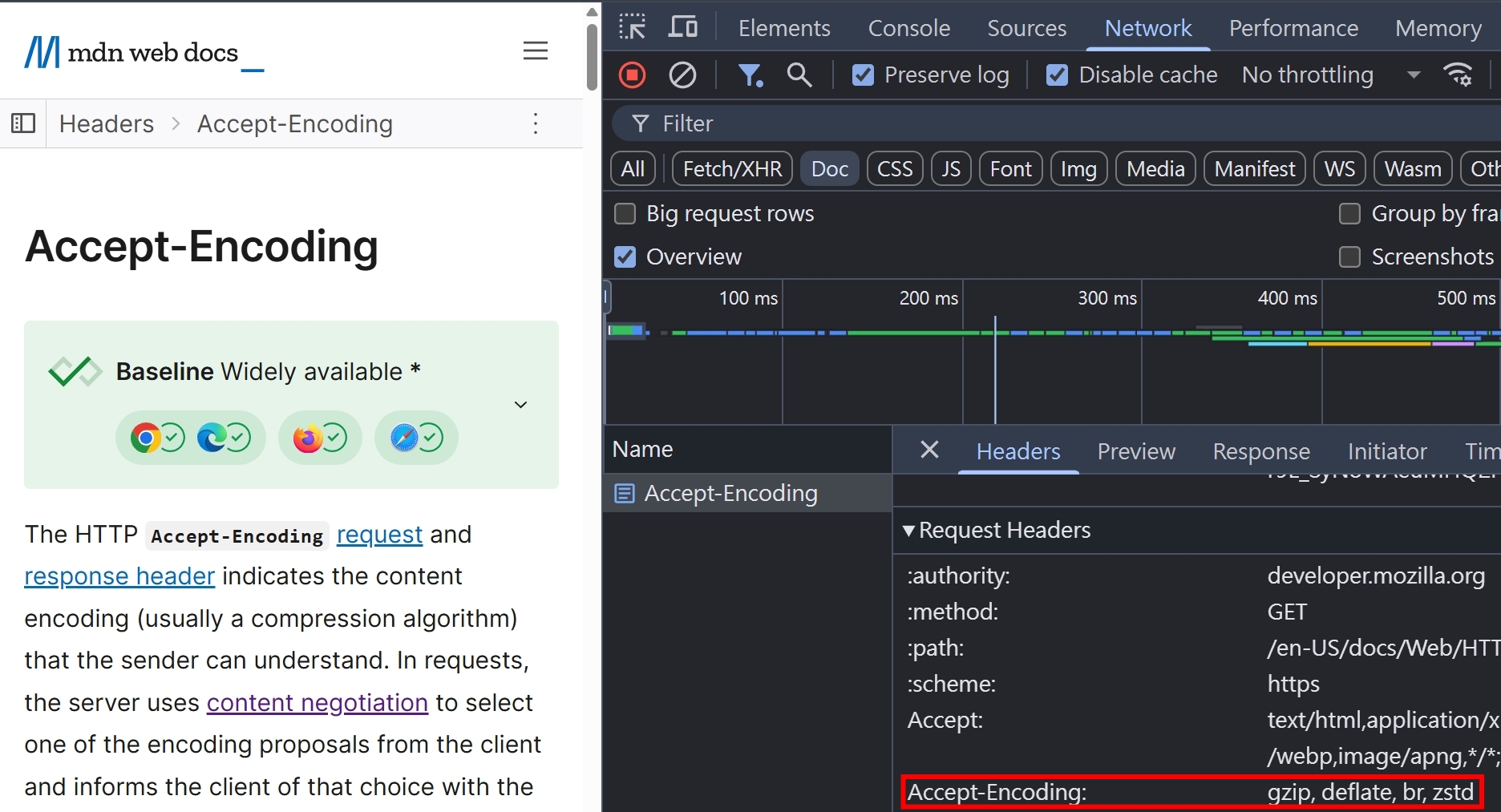
這是瀏覽器預設就會發送的 Request Header,代表瀏覽器支援這些資料壓縮的演算法
Accept-Encoding 深入研究
Accept-Encoding也可以作為 Response Header,用來告訴 client 端,Server 支援哪些資料壓縮的演算法- 不一定要有空格,也可以是
Accept-Encoding: gzip,deflate,br,zstd的形式,Server 需要正確的處理這兩種情境 - 加上權重(q)的表達方式,
Accept-Encoding: br;q=1.0, gzip;q=0.8,其中權重(q)是一個介於 0 ~ 1 的值,通常會使用降冪排序,但這部分似乎沒有硬性規定,所以 Server 也是需要正確處理權重(q)的排序 Accept-Encoding: *=> 接受任何的資料壓縮形式Accept-Encoding: identity=> 原始資料直接回傳就好,不要再壓縮了Accept-Encoding: gzip, identity;q=0=> 回傳的資料一定要壓縮,如果 Server 不支援 gzip 壓縮方法,必須回傳 406 Not Acceptable
HTTP 常見的壓縮演算法
排序代表的意義
- Server 需要根據這個優先順序
gzip, deflate, br, zstd來決定要使用哪個壓縮演算法 - 根據我查到的資料,
gzip, deflate, br, zstd這個順序是根據這些演算法的普及度、效率和兼容性考慮 - 以這些演算法的問世時間從遠到近排序的話,
deflate, gzip, br, zstd
使用 NodeJS zlib + HTTP serve 壓縮後的靜態資源
NodeJS 有原生的模組 zlib,專門處理壓縮跟解壓縮的邏輯,常見的 gzip, deflate, br 演算法都有支援,唯獨 zstd 是比較新的演算法,在目前 (NodeJS v23.11.0)[https://nodejs.org/api/zlib.html#for-zstd-based-streams] 是還在實驗中的 API,故本篇就不使用。
我們創建一個路由, serve react 18 的靜態文檔
import { readFileSync } from "node:fs";
import httpServer from "../httpServer";
import { gzipSync, brotliCompressSync, deflateSync } from "node:zlib";
import { join } from "node:path";
// 使用 react 18.3.1 當作要 serve 的靜態資源,並且預先壓縮
const selfHostReactJs = readFileSync(join(__dirname, "./react.development.js"));
const gzipSelfHostReactJs = gzipSync(selfHostReactJs);
const brotliSelfHostReactJs = brotliCompressSync(selfHostReactJs);
const deflateSelfHostReactJs = deflateSync(selfHostReactJs);
const encodedSelfHostReactJsMap = {
gzip: gzipSelfHostReactJs,
deflate: deflateSelfHostReactJs,
br: brotliSelfHostReactJs,
};
type ServerAcceptedEncoding = keyof typeof encodedSelfHostReactJsMap;
type EncodingPreference = { encoding: string; q: number };
httpServer.on("request", function requestListener(req, res) {
if (req.url === "/favicon.ico") return faviconListener(req, res);
const acceptEncoding = req.headers["accept-encoding"];
const encodingPreferenceList: EncodingPreference[] = String(acceptEncoding)
.split(",")
.map((part) => {
const [encoding, qPart] = part.trim().split(";");
const q = qPart ? parseFloat(qPart.split("=")[1]) : 1.0;
return { encoding: encoding.trim(), q };
})
// 依照 q-value 排序,從高到低
.sort((a, b) => b.q - a.q);
// 暫不處理 identity 或是 * 或是 q=0 這些特殊情境
for (const { encoding } of encodingPreferenceList) {
const encodedSelfHostReactJs =
encodedSelfHostReactJsMap[encoding as ServerAcceptedEncoding];
if (encodedSelfHostReactJs) {
res.setHeader("Content-Encoding", encoding);
res.end(encodedSelfHostReactJs);
return;
}
}
return res.end(selfHostReactJs);
});
使用瀏覽器打開 http://localhost:5000/ ,查看壓縮過後的文件體積
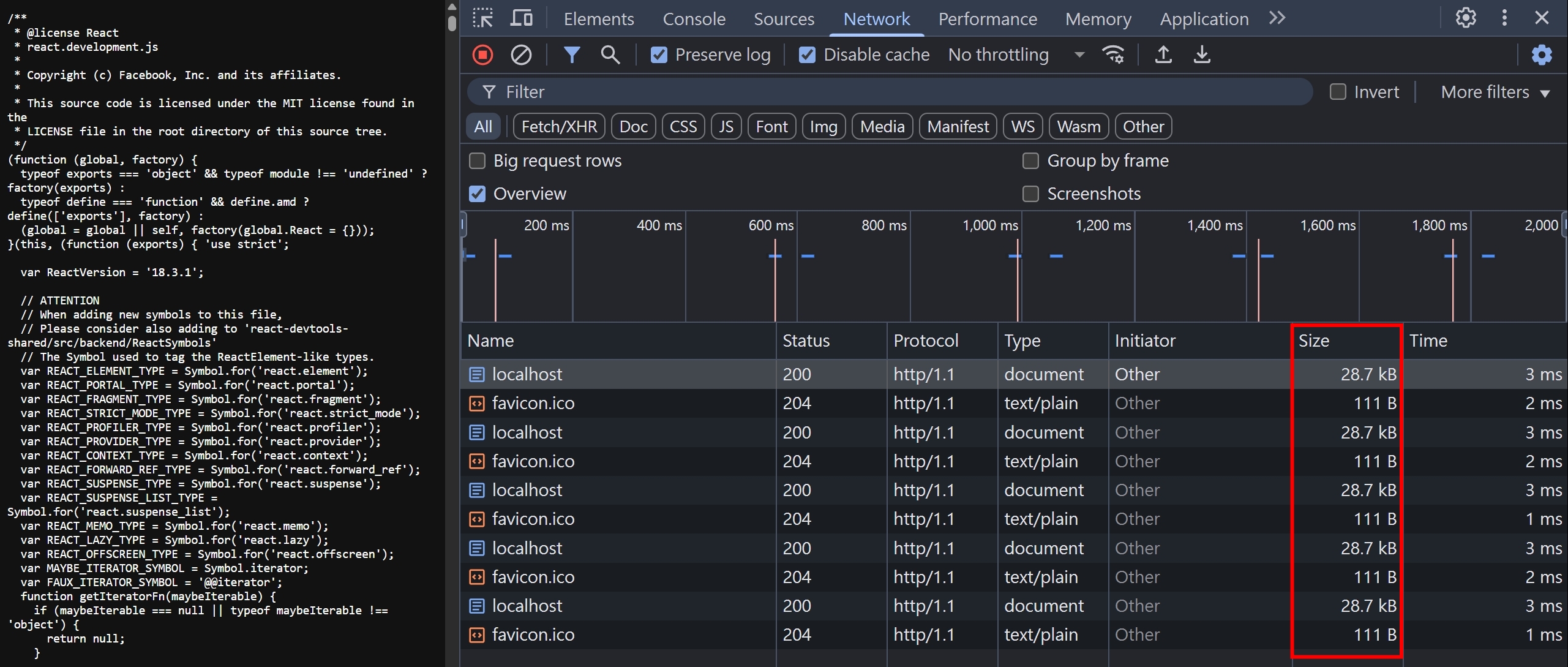
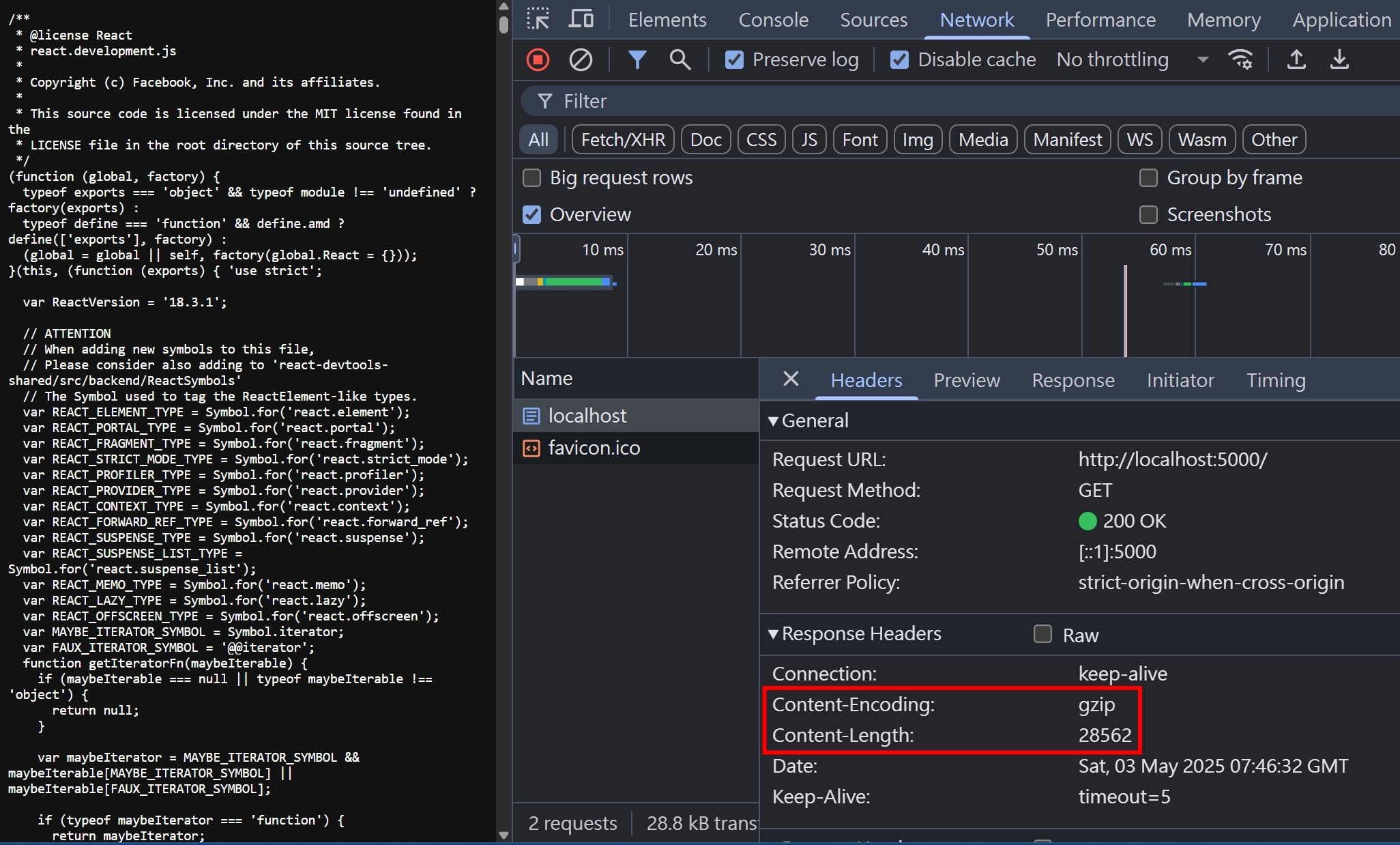
壓縮後的體積是 28.7 KB,我們再來看看不壓縮的情況
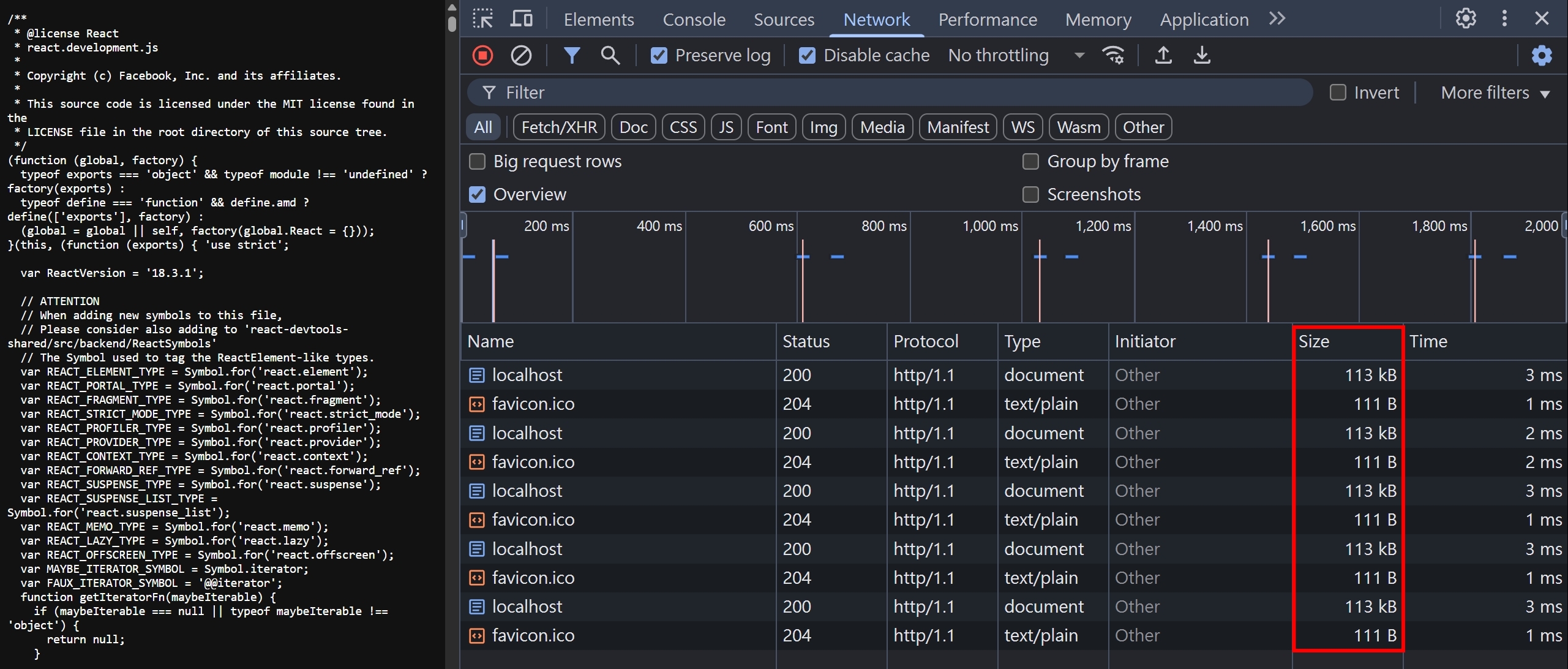
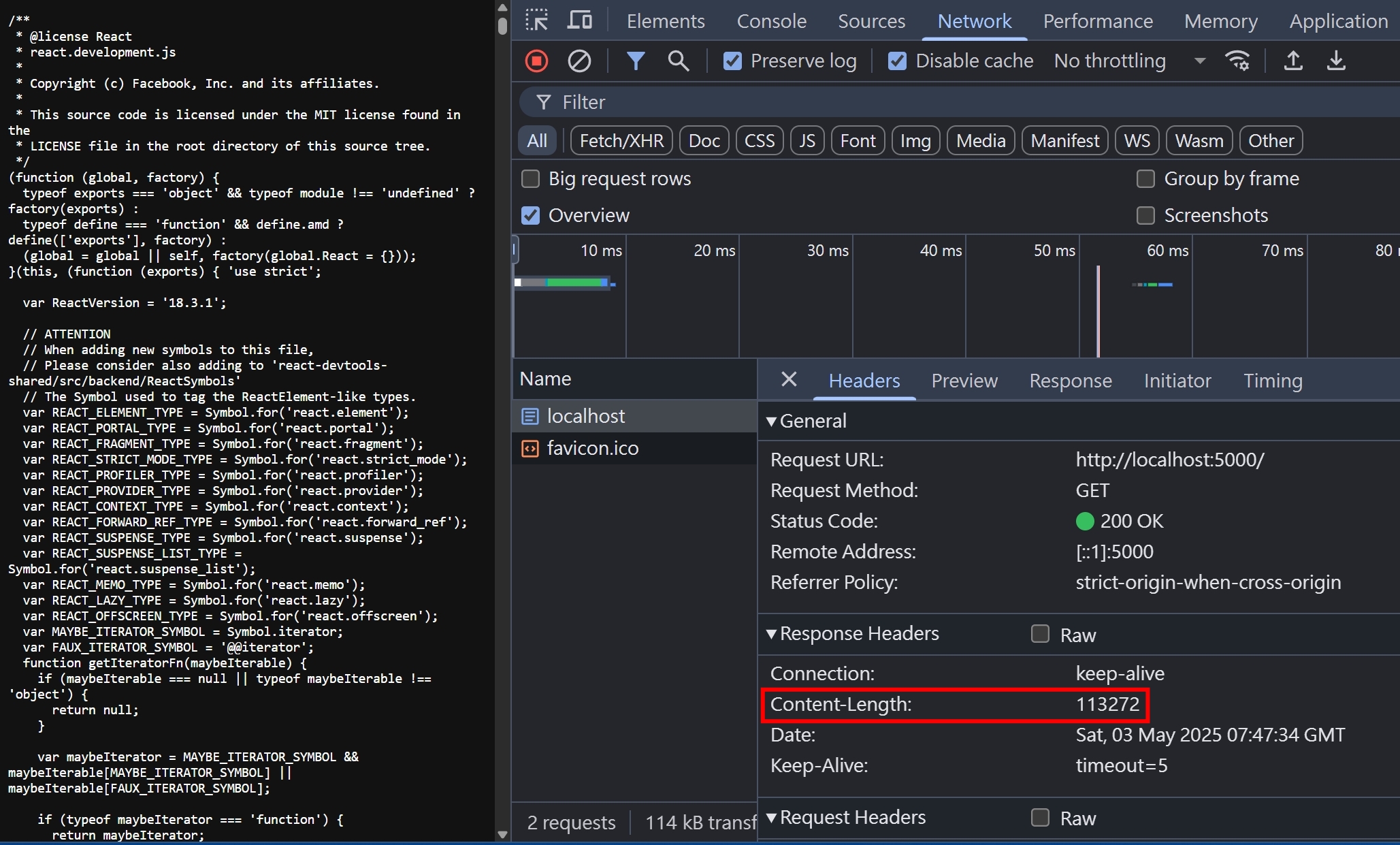
沒壓縮的情況,體積是 113 KB,可以感受到這個壓縮比還是非常有感的
Content-Encoding
上面的程式碼範例,Server 在成功 match 到 client 端的 Accept-Encoding 之後,會回傳 Content-Encoding 的 HTTP Header。client 端收到以後,就會根據這個值去做對應的解壓縮。
錯誤的 Content-Encoding 會發生什麼事情
我們改寫一下 NodeJS 程式碼(只列出異動部分)
httpServer.on("request", function requestListener(req, res) {
res.setHeader("Content-Encoding", "br");
return res.end(selfHostReactJs);
});
然後重整瀏覽器,應該會看到白頁,並且顯示 ERR_CONTENT_DECODING_FAILED,代表瀏覽器無法正確使用 Server 提供的 Content-Encoding 進行解壓縮

client 傳送壓縮後的資訊給 server
上面的範例 是 Server 處理壓縮的邏輯,但 Content-Encoding 也可以當作 Request Header。我們使用瀏覽器於 2023-05 新增的 Compression Streams API 來處理 client 端的 gzip 壓縮(這段程式碼稍微複雜,牽涉到很多 js 偏底層的概念,包含 ArrayBuffer, ReadableStream, Uint8Array, CompressionStream, Blob)
async function fetchAndCompressToGzip() {
try {
const response = await fetch(
"https://unpkg.com/react@18.3.1/umd/react.development.js",
);
const originalData = await response.arrayBuffer();
const readableStream = new ReadableStream({
start(controller) {
controller.enqueue(new Uint8Array(originalData));
controller.close();
},
});
const compressedStream = readableStream.pipeThrough(
new CompressionStream("gzip"),
);
const reader = compressedStream.getReader();
const chunks = [];
while (true) {
const { done, value } = await reader.read();
if (done) break;
chunks.push(value);
}
const gzippedBlob = new Blob(chunks, {
type: "application/javascript; charset=utf-8",
});
return gzippedBlob;
} catch (error) {
console.error("壓縮過程出錯:", error);
throw error;
}
}
async function sendGzippedBlobToServer(body) {
const response = await fetch("http://localhost:5000/postGzipped", {
method: "post",
headers: {
"Content-Encoding": "gzip",
},
body,
}).then((res) => res.text());
}
async function main() {
const gzippedBlob = await fetchAndCompressToGzip();
const text = await sendGzippedBlobToServer(gzippedBlob);
console.log(text);
}
main();
稍微調整一下 NodeJS 的程式碼,處理 /postGzipped 的路由(僅列出異動部分),把 client 傳送的 gzipped react 原始碼解壓縮,並且回傳。
if (req.url === "/") {
// ...無異動
} else if (req.url === "/postGzipped" && req.method?.toLowerCase() === "post") {
// 檢查 contentEncoding 是否為 Server 可處理的類型
const contentEncoding = req.headers["content-encoding"];
if (contentEncoding !== "gzip") {
res.statusCode = 415;
res.setHeader("Accept-Encoding", "gzip");
res.end();
return;
}
// 檢查 contentType 是否有值
const contentType = req.headers["content-type"];
if (!contentType) {
res.statusCode = 400;
res.setHeader("Content-Type", "text/plain");
res.end("Invalid Content Type");
return;
}
// 開始讀取 req.body
const chunks: Buffer[] = [];
req.on("data", (chunk: Buffer) => {
chunks.push(chunk);
});
req.on("end", () => {
const decompressedBuffer = gunzipSync(Buffer.concat(chunks));
const decompressedString = decompressedBuffer.toString("utf-8");
// 非最佳實踐,需先確認為合法的 contentType
res.setHeader("Content-Type", contentType);
res.end(decompressedString);
});
} else return notFoundListener(req, res);
打開瀏覽器 F12 > Console,執行上面的 main(),並且切到 Network 觀察
- Request Header 有正確帶上
Content-Type跟Content-Encoding,並且Content-Length是壓縮過後的體積 - Response Header 有正確帶上
Content-Type,並且Content-Length是解壓縮過後的體積
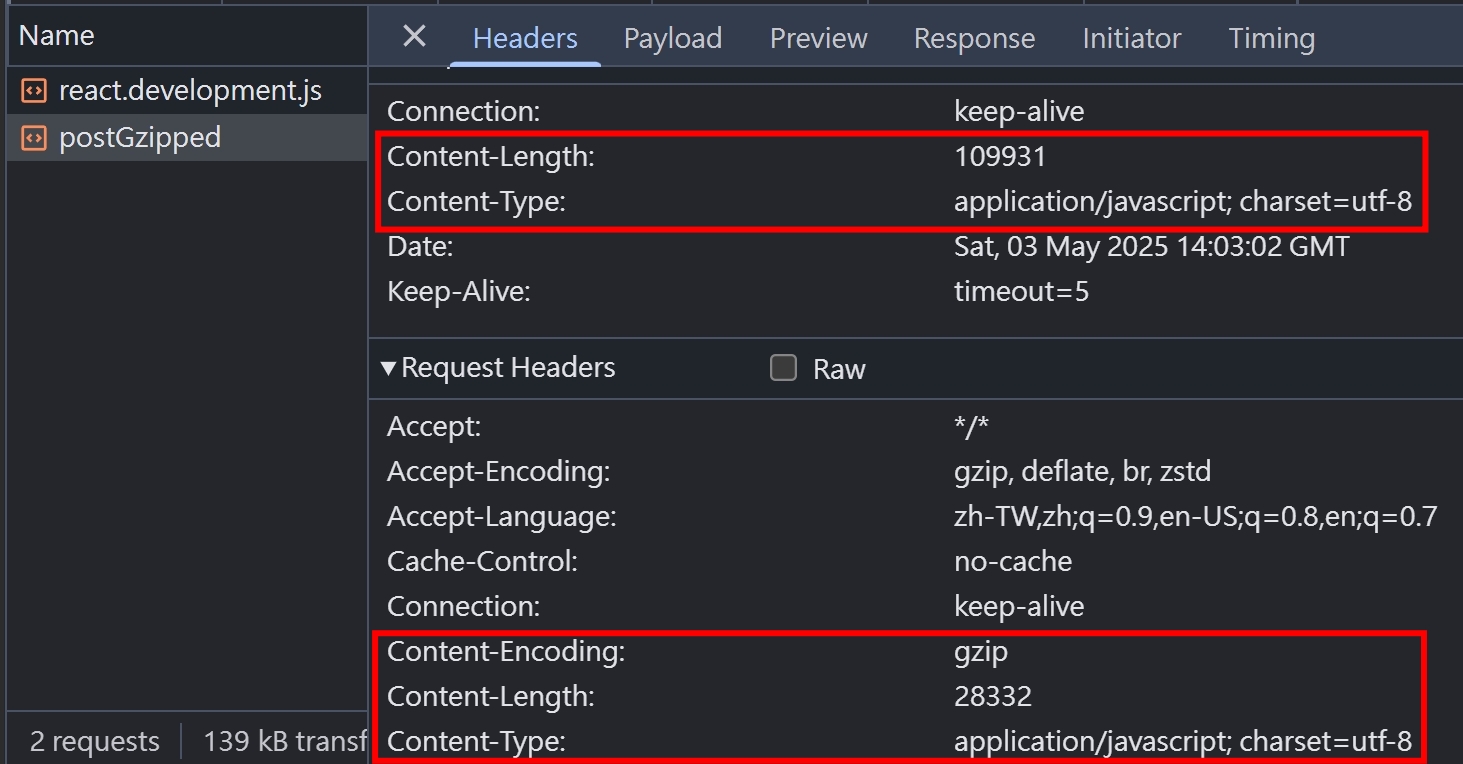
Request Body 是壓縮後的資料

Response body 是解壓縮後的資料
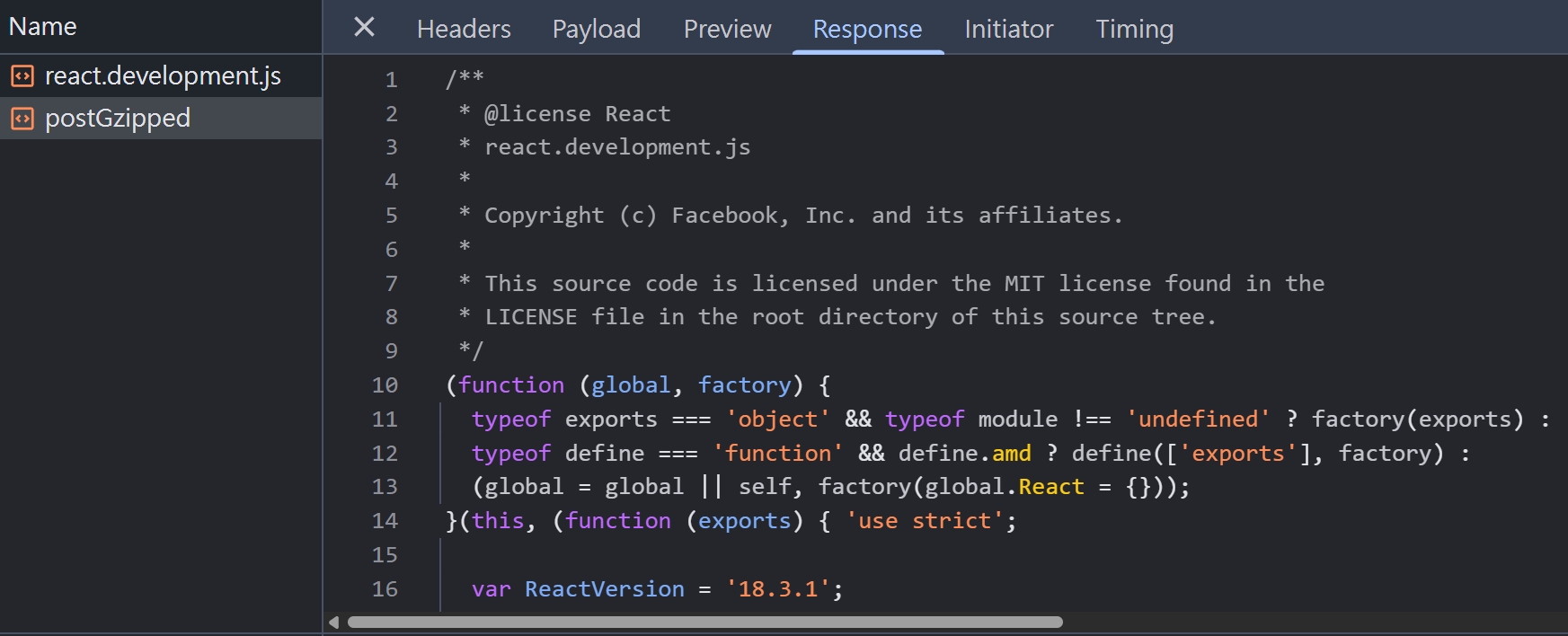
Accept-Encoding as Response Header
上面的 /postGzipped 路由,其實已經有正確處理 415 Unsupported Media Type 的情況,我們只需要稍微改寫 client 端的程式碼,把 Content-Encoding 拔掉
async function sendGzippedBlobToServer(body) {
const response = await fetch("http://localhost:5000/postGzipped", {
method: "post",
headers: {
// "Content-Encoding": "gzip",
},
body,
}).then((res) => res.text());
}
重新執行 main(),應該會看到 Server 有正確處理 415 Unsupported Media Type 的情況

client 端沒有明確指定 Content-Type
這時候 Server 有幾種處理方式:
- Server 自行處理 MIME sniffing
- 回傳 400 Bad Request
- 其他...
上面的 NodeJS 程式碼範例,我們使用 2. 回傳 400 Bad Request 來處理,我們稍微改寫 client 端程式碼,把 Blob 的 Content-Type 拔掉,測試看看 Server 是否正確回應:
async function fetchAndCompressToGzip() {
try {
// 省略
const gzippedBlob = new Blob(chunks);
return gzippedBlob;
} catch (error) {
// 省略
}
}
重新執行 main(),應該會看到 Server 有正確處理 400 Bad Request 的情況

插曲
在寫這篇文章的時候,其實我還順便發現了 node 跟 @types/node 的兩個錯誤,並且順便發 PR 修正了
參考資料
- https://developer.mozilla.org/en-US/docs/Web/HTTP/Compression
- https://developer.mozilla.org/en-US/docs/Glossary/Lossless_compression
- https://developer.mozilla.org/en-US/docs/Glossary/Lossy_compression
- https://developer.mozilla.org/en-US/docs/Glossary/Brotli_compression
- https://developer.mozilla.org/en-US/docs/Glossary/gzip_compression
- https://developer.mozilla.org/en-US/docs/Glossary/Zstandard_compression
- https://developer.mozilla.org/en-US/docs/Web/HTTP/Guides/Compression_dictionary_transport
- https://developer.mozilla.org/en-US/docs/Web/HTTP/Headers/Content-Encoding
- https://developer.mozilla.org/en-US/docs/Web/HTTP/Headers/Accept-Encoding
- https://developer.mozilla.org/en-US/docs/Glossary/Quality_values
- https://developer.mozilla.org/en-US/docs/Web/API/Compression_Streams_API
- https://developer.mozilla.org/en-US/docs/Web/API/ReadableStream/ReadableStream
- https://nodejs.org/docs/latest-v22.x/api/zlib.html